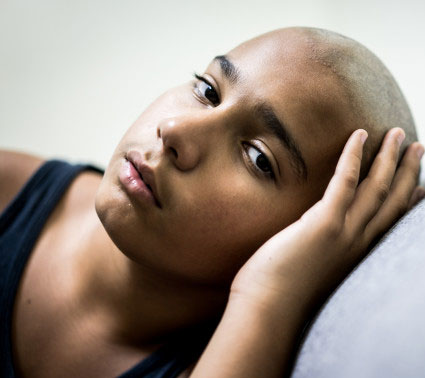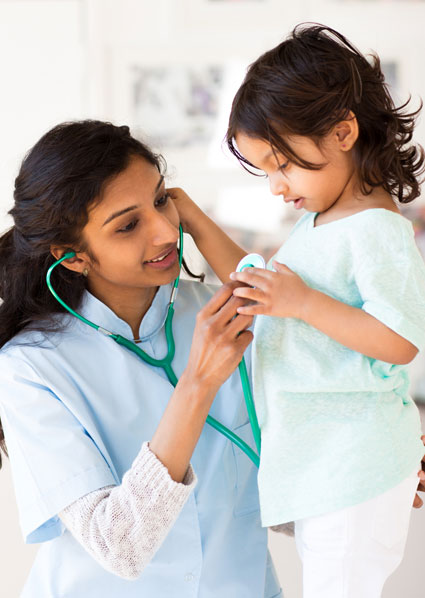Childhood Cancer
Cancer occurs in people of all ages including children. However, cancer in children is rare and is curable if detected early and treated effectively.
- Every year, over 3 lakh children are diagnosed with Cancer all over the world.
- In India, nearly more than 50,000 new childhood cancer cases occur every year.
- In the west, the survival rate is as high as 80-90% in some cancers. With a conservative estimate of 70% survival rate, many survivors are added to population every year.
- Cancers in childhood are best treated at Paediatric cancer units by specialised disease management groups . Age group of 0-14 is considered as paediatric age group, some centres also consider age up to 18 years.

Symptoms of Childhood Cancer
Adults can observe the signs and symptoms of cancer in their bodies and maybe take some action however, in children, it is difficult to understand and observe any signs and symptoms under all the regular play accidents, bruises or any common illnesses. It is difficult to detect cancer in children as they are rare compared to adults.
Some symptoms are:
- Continued, unexplained weight loss
- Headaches, often with early morning vomiting
- Increased swelling or persistent pain in the bones, joints, back, or legs
- Lump or mass, especially in the abdomen, neck, chest, pelvis, or armpits
- Development of a whitish appearance in pupil of the eye or changes in the vision
- Recurrent fevers not caused by infections
- Excessive bruising or bleeding (often sudden)
- Noticeable paleness or prolonged tiredness
Risk Factors
A risk factor is anything that increases the chances of getting a disease such as cancer. Childhood cancers do not have a known cause.
Many studies have shown how any changes or mutation in the DNA inside our cells can contribute to the production of cancer cells. Studies show that 5-10 % of childhood cancers are caused due to genetic factors which can be inherited or acquired.
Types of Childhood Cancers
There are many types of childhood cancers and they are quite different from the adult cancers. Adult cancers majorly originate in organs whereas childhood cancer involves tissues (hematopoietic, lymphatic, central nervous system, muscle , bone etc).
Awareness about the signs and symptoms is necessary for early diagnosis, in India majority of the cases presenting to the oncology centres come at late stages where dissemination has already occurred.
Blood Cancers
Leukemias
Childhood acute lymphoblastic leukemia (ALL) is a type of cancer in which the bone marrow makes too many immature lymphocytes (a type of white blood cell).
Leukemia may affect red blood cells, white blood cells, and platelets.
Lymphomas
Lymphoma is a broad term for cancer that begins in cells of the lymph system. The two main types are Hodgkin lymphoma and Non-Hodgkin lymphoma (NHL). Hodgkin lymphoma can often be cured. The prognosis of NHL depends on the specific type.
Brain Tumors
A childhood brain or spinal cord tumor is a disease in which abnormal cells form in the tissues of the brain or spinal cord.
The brain controls many important body functions. The spinal cord connects the brain with nerves in most parts of the body.
Brain and spinal cord tumors are a common type of childhood cancer. Some tumors are benign and some children can be cured by surgery.
Bone Cancers
Bone cancer is rare and includes several types. Some bone cancers, including osteosarcoma and Ewing sarcoma, are seen most often in children and young adults.
Neuroblastoma
Neuroblastoma is a cancer of immature nerve cells that most often occurs in young children. It usually begins in the adrenal glands but can form in the neck, chest, abdomen, and spine.
Wilms’ Tumor
Arises in the kidney most often appears in children, usually between the ages of two and four, and is very different from adult kidney cancers, cure rates are very high with early diagnosis.
Rhabdomyosarcoma
Rhabdomyosarcoma usually begins in muscles that are attached to bones and that help the body move, but it may begin in many places in the body. Rhabdomyosarcoma is the most common type of soft tissue sarcoma in children.
Retinoblastoma
Retinoblastoma is cancer of the retina. Retinoblastoma is a rare type of eye cancer that can affect young children, usually under the age of 5. if it's picked up early, retinoblastoma can often be successfully treated.
Retinoblastoma can either affect one or both eyes. If it affects both eyes, it's usually diagnosed before a child is one year old. If it affects one eye, it tends to be diagnosed later (between the ages of 2 and 3). Since early detection saves the vision and also life, it is important to focus on the signs and symptoms
Signs and symptoms of retinoblastoma include:
- an unusual white reflection in the pupil – it often looks like a cat's eye that's reflecting light and may be apparent in photos where only the healthy eye appears red from the flash, or you may notice it in a dark or artificially lit room
- a squint
- a change in the colour of the iris
- a red or inflamed eye
- poor vision
- These symptoms should be checked by your GP as soon as possible.

Screening
Screening is testing for a disease such as cancer in people who do not have any symptoms . As childhood cancers are rare, there are no widely recommended screening tests to look for cancer in children who are not at increased risk.
Some children may be at a higher risk of acquiring a particular type of cancer due to the genetic factor i.e. if the child’s brother, sister, mother or father is affected with Cancer. Such children need careful attention and regular medical-screenings.

Diagnostic Tests
Early diagnosis consists of 3 components:
- Awareness by families and accessing care
- Clinical Evaluation, diagnosis and staging (determining the extent to which a cancer has spread)
- Accessibility to treatment
It is important to consult a doctor if you notice any of the signs or symptoms mentioned above or any other symptom outside the above list but is persistent.

Treatment of Childhood Cancer
Common treatments include: surgery, chemotherapy, radiation therapy, immunotherapy, and stem cell transplant, The paediatric oncology team of the hospital will detail the protocol for the specific cancer type and the stage.

Late effects of treatment
Survivorship is a distinct phase in cancer care continuum. After the treatment is completed, follow up is essential to monitor for late effects. The late effects are the complications of cancer therapy ranging from impaired growth and development, neurocognitive and psychosocial deficits, cardiopulmonary problems, endocrine organ dysfunction, gastrointestinal problems and secondary malignancies. Not every survivor experiences late effects, however it is important to catch them early. Survivors may need support for investigations and treatment of late effects such as growth hormone support, prosthesis support, fertility, hearing aids, etc.

Coping & Support
It can be a traumatic experience to watch your child suffer through Cancer. It is only natural to have stress and anxiety and fears about the future. However, it is important for parents to stay strong and support their child in this through various ways.
- Speak to your Paediatric Oncologist
Speak to the doctor in detail and clear all your doubts to know what is best suited for your child. Knowing more about your cancer and your options will help you feel more confident when making treatment decisions. Ask about all the treatment options and financial arrangements.
Talk with other child cancer survivors. You may find it helpful and encouraging to talk to others in your same situation. Ask your Doctor about support groups in the hospital and you can also find them online.
- Share your feelings
Find a friend or family member who is a good listener to speak about your thoughts and feelings. Ask your doctor for a referral to a counsellor who works with children cancer patients and survivors.
- Seek the support of your friends and family
Your friends and family can provide crucial support during the cancer treatment.
After completion of therapy, majority of children can live a regular life and relive their dreams and inspire other children suffering from cancer to have hope. Survivors can help and support each other through various support group programs.In summary, it is very important to not ignore any signs and symptoms that your child faces persistently. As accurate and timely diagnosis with effective treatment is the only way to fight childhood cancer and increase the probability of survival, reduce the suffering and cater to a less expensive treatment. It is important to see a paediatric doctor and equally important to access best treatment facilities where comprehensive care to children with cancer is provided.
Read More https://www.indiancancersociety.org/cancer-information/childhood-cancer.aspx